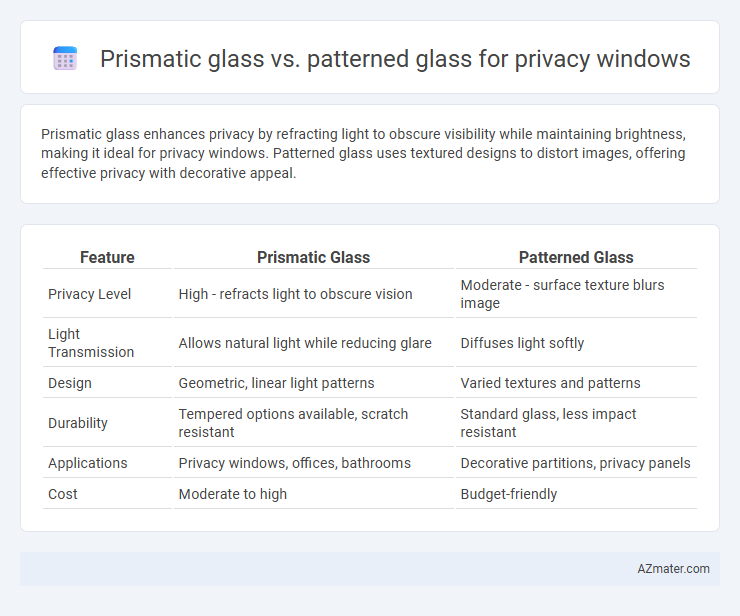Prismatic glass enhances privacy by refracting light to obscure visibility while maintaining brightness, making it ideal for privacy windows. Patterned glass uses textured designs to distort images, offering effective privacy with decorative appeal.
Table of Comparison
| Feature | Prismatic Glass | Patterned Glass |
|---|---|---|
| Privacy Level | High - refracts light to obscure vision | Moderate - surface texture blurs image |
| Light Transmission | Allows natural light while reducing glare | Diffuses light softly |
| Design | Geometric, linear light patterns | Varied textures and patterns |
| Durability | Tempered options available, scratch resistant | Standard glass, less impact resistant |
| Applications | Privacy windows, offices, bathrooms | Decorative partitions, privacy panels |
| Cost | Moderate to high | Budget-friendly |
Introduction to Privacy Window Solutions
Prismatic glass and patterned glass both serve as effective privacy window solutions by diffusing light while obscuring direct visibility. Prismatic glass utilizes faceted designs to refract light and enhance privacy without compromising natural illumination. Patterned glass features textured surfaces that scatter light and create visual barriers, making it ideal for applications requiring discreet yet light-permeable windows.
Understanding Prismatic Glass: Features and Benefits
Prismatic glass enhances privacy while maximizing natural light through its unique surface design that refracts and diffuses light effectively. Its structured patterns provide clear obscuration without sacrificing brightness, making it ideal for privacy windows in offices and bathrooms. Compared to patterned glass, prismatic glass offers superior light control and energy efficiency by reducing glare and heat transmission.
What is Patterned Glass? Types and Characteristics
Patterned glass is textured glass designed to obscure visibility while allowing light to pass through, making it ideal for privacy windows. Common types include hammered, rain, reed, and frosted patterns, each offering distinct surface textures and light diffusion effects. These characteristics enhance privacy by distorting shapes and outlines, preventing clear views while maintaining brightness in interior spaces.
Comparing Aesthetics: Prismatic vs Patterned Glass
Prismatic glass offers a sleek, modern aesthetic with its light-diffusing properties that create vibrant, refracted patterns, enhancing natural light while maintaining privacy. Patterned glass provides a textured and decorative look, featuring various embossed designs that obscure visibility more directly and add a classic or artistic element to window spaces. Both glass types prioritize privacy but differ in style, with prismatic glass delivering a contemporary, luminous effect and patterned glass offering traditional ornamental appeal.
Privacy Levels: Which Glass Offers Better Obscurity?
Prismatic glass disperses light through geometric patterns that create a blurred effect, offering moderate privacy while allowing natural light to pass through. Patterned glass features textured surfaces that distort shapes and obscure visibility more effectively, making it a superior choice for higher privacy needs. For environments requiring maximum obscurity without compromising light transmission, patterned glass generally provides better privacy levels than prismatic glass.
Light Transmission and Diffusion Qualities
Prismatic glass offers high light transmission with enhanced diffusion, effectively dispersing natural light evenly across a space while maintaining privacy by obscuring direct visibility. Patterned glass provides varying levels of light diffusion depending on the design, often reducing transparency more than prismatic glass, which results in stronger privacy but can decrease overall light transmission. Selecting prismatic glass is ideal when maximizing daylight illumination is crucial, whereas patterned glass suits environments prioritizing privacy with moderate light filtering.
Durability and Maintenance Considerations
Prismatic glass offers superior durability due to its thicker construction and resistance to scratches, making it ideal for long-term privacy window solutions with minimal maintenance. Patterned glass, while providing aesthetic variety and moderate durability, may require more frequent cleaning to prevent dirt accumulation in its textured surfaces. Both types maintain privacy effectively, but prismatic glass generally demands less upkeep and offers enhanced resistance to wear over time.
Cost Comparison: Prismatic vs Patterned Glass
Prismatic glass generally incurs higher costs than patterned glass due to its complex manufacturing process that involves precision-engineered prismatic surfaces to enhance light diffusion and privacy. Patterned glass, featuring embossed or textured designs, offers a more economical option while still providing effective privacy and decorative appeal. When budgeting for privacy windows, patterned glass is usually preferred for cost-sensitive projects, whereas prismatic glass suits premium applications demanding superior light control and aesthetic quality.
Ideal Applications: Where Each Glass Excels
Prismatic glass excels in commercial and office environments requiring controlled daylight diffusion and enhanced visual comfort, such as conference rooms and lobbies, by directing light while maintaining privacy. Patterned glass is ideal for residential bathrooms, partitions, and storefronts where decorative privacy with obscured visibility is essential, blending aesthetic appeal with functional concealment. Both types optimize privacy, but prismatic glass prioritizes light manipulation, while patterned glass emphasizes texture and design variety.
Making the Right Choice for Your Privacy Window
Prismatic glass offers superior light diffusion and clarity while maintaining privacy, making it ideal for spaces where natural light is essential without compromising seclusion. Patterned glass provides a decorative element with varied textures that obscure vision, enhancing privacy but may slightly reduce light transmission. Selecting between prismatic and patterned glass depends on balancing desired light quality, aesthetic preferences, and the level of visual privacy required for your specific window application.

Infographic: Prismatic glass vs Patterned glass for Privacy window
 azmater.com
azmater.com